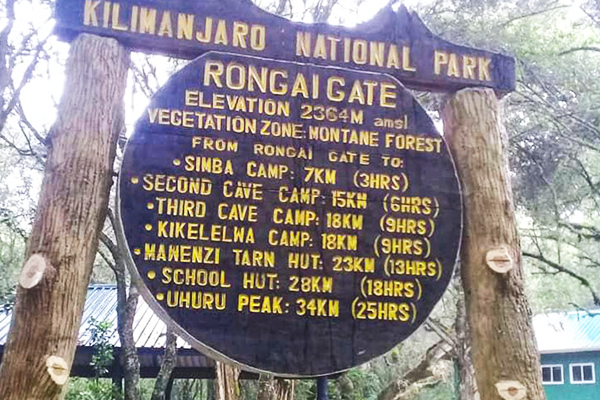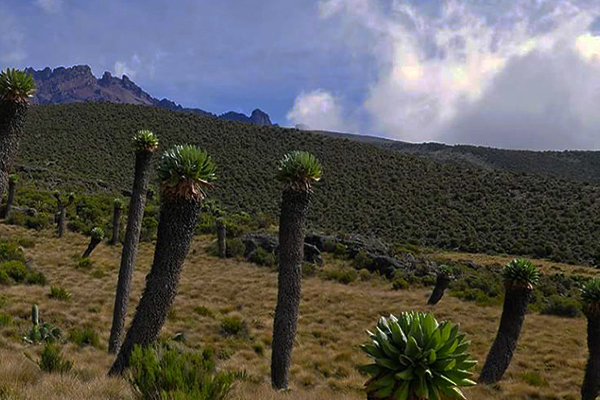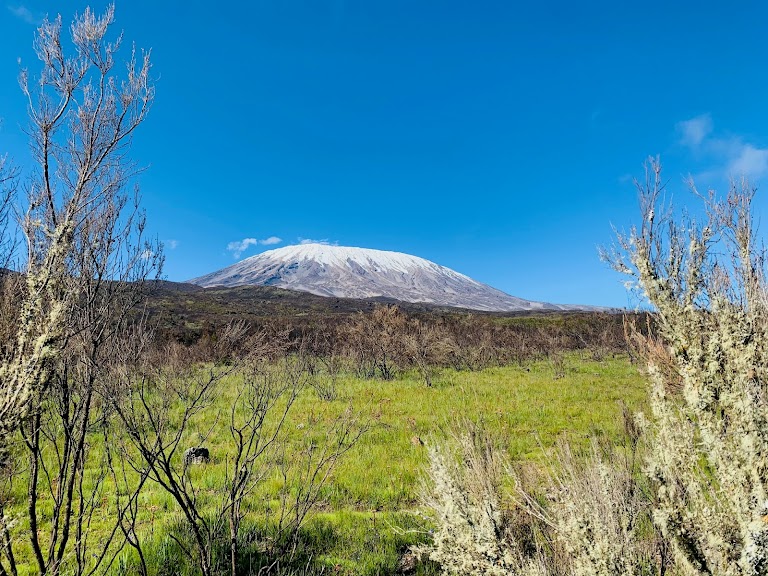Rongai Route in Brief
Named after the village of its origin, the Rongai route starts on Kilimanjaro’s northern side, near the Kenyan border, making it a remote trail. It’s favored by beginners for its gentler ascents, though its success rate is lower due to limited opportunities for high-altitude acclimatization.
For increased success, consider a 7-day Rongai itinerary, providing a day for acclimatization. Experienced climbers may opt for a 6-day itinerary.
The hike starts through a small forest, and as you ascend, catch glimpses of Kenya and panoramic views of Amboseli National Park, Lake Jipe, and Lake Chala. Keep an eye out for wildlife like elephants, buffalos, and elands, adding a touch of adventure to your trek.


Interesting facts about the Rongai route
- The solitary trail ascending Kilimanjaro's northern slope.
- Rongai route has a reputation of being the most preferred route during rainy season.
- Rongai route has fewer steep sections.
- You will use Marangu route to descend the mountain.
- Our Rongai route offer starts at $2150 per person
Some photos from Rongai route






Rongai Route Itineraries
6 Days Rongai Route, Starts at $2150 Per person
Distance: 7km
Trekking time: 4-6 hours
Zone: Tropical Rainforest
Altitude gain: 730 meters
Upon registering at the Rongai Gate (the starting point), your trek commences through a rainforest, gradually ascending to Simba Camp (today’s final destination). Meandering through a potato farm adds a touch of local charm to your journey. Keep an eye out for wildlife, including Colobus monkeys. This leg offers a relatively easy hike, covering approximately 7 km.
Note that the word Simba means lion. The camp got its name from info that a lion was once spotted around this area.
Distance: 13km
Trekking time: 6-8 hours
Zone: Moorland
Altitude gain: 779 meters
After a good breakfast at Simba Camp, we’re setting off on a climb to Kikulelwa Camp. Today is where the 7-day and 6-day Rongai routes differ. Unlike the 7-day plan that spends a night at Second Cave Camp, our 6-day journey skips that part and heads straight to Kikulelwa for the night.
We’ll stray from the main path and take a smaller trail leading to the rocky tops of Mawenzi. Finally, we’ll reach our last stop for the day, Kikulelwa Camp. It’s a change in the route, but it means a cozy night’s stay at this camp, nestled in the beauty of Kilimanjaro. It’s a strategic pause before we tackle more heights on this adventure.
Distance: 9km
Trekking time: 5-6 hours
Zone: Alpine desert
Altitude gain: 715 meters
After breakfast, we’ll tackle a steep climb to reach our final stop, the famous Mawenzi Tarn Camp. This campsite, nestled under the towering cliffs of Mawenzi peak, offers stunning views of the Kenyan plains. Arriving early means a warm lunch and a chance for a walk around this area to get used to the altitude. It’s a day of both effort and enjoyment, surrounded by incredible landscapes.
Note: The campsite got its name from a tarn ( a small mountain lake) that exists in that area.
Distance: 9km
Trekking time: 4-5 hours
Zone: Alpine desert
Altitude gain: 715 meters
After breakfast, you will start a gradual ascent through the lunar desert of the “Saddle” between Mawenzi and Kibo.
Today’s hike leads to the base camp called Kibo Hut, which is nestled at the foot of the Kibo crater wall. As evening descends, savor an early dinner at Kibo Hut, setting the stage for a well-deserved rest ahead of the summit attempt.
Distance: Kibo Hut to Uhuru Peak about 6.5km
Uhuru Peak to Horombo Hut 15.5km making a total of 22km
Trekking time:
6-8 hours to Uhuru Peak, then 5-6 hours from Uhuru Peak to Horombo Hut
Zone: Arctic zone then Heath
Altitude gain: 1175 meters then
altitude loss:2175 meters
The eagerly awaited summit night is upon you, where both your mental resilience and physical strength will be put to the ultimate test.
Upon awakening, a serving of hot drinks and biscuits will precede the commencement of the summit hike, with the initial destination being Gilman’s Point at 5685 meters, situated on Kibo’s crater rim.
At Gilman’s Point, a brief rest of no more than 5 minutes awaits, allowing time to refuel with a snack.
The final ascent will then unfold at a deliberate pace, conquering the remaining 200 meters to Uhuru Peak. After capturing moments with photos and celebrating at Uhuru Peak, the descent journey begins, leading back to Kibo Hut and onward to Horombo Hut.
Distance: 19km
Trekking time: 6-8 hours
Zone: Rainforest
Altitude loss: 1750 meters
Exhausted yet undoubtedly elated, you’ve now realized your dream of conquering Africa’s highest peak. While traversing the rainforest during your descent, anticipate encounters with Colobus monkeys and other small creatures. The challenging descent includes a lunch stop at Mandara Hut before progressing to Marangu Gate.
7 Days Rongai Route, Starts at $2350 Per person
Distance: 7km
Trekking time: 4-6 hours
Zone: Tropical Rainforest
Altitude gain: 730 meters
Upon registering at the Rongai Gate (the starting point), your trek commences through a rainforest, gradually ascending to Simba Camp (today’s final destination). Meandering through a potato farm adds a touch of local charm to your journey. Keep an eye out for wildlife, including Colobus monkeys. This leg offers a relatively easy hike, covering approximately 7 km.
Note that the word Simba means lion. The camp got its name from info that a lion was once spotted around this area.
Distance: 8km
Trekking time: 3-4 hours
Zone: Heath
Altitude gain: 779 meters
After breakfast at Simba Camp, we will start a fairly steady ascend towards Second Cave Camp located in the moorland zone. At Second Cave Camp, you will get great views of Kibo Peak and the Eastern Ice Fields. Your final destination today is Second Cave Campsite named after the cave that was used by climbers in the old days.
Distance: 5km
Trekking time: 3-4 hours
Zone: Moorland
Altitude gain: 150 meters
Today, we’re only going up by about 150 meters, walking through the moorland area. We’ll leave the main path and take a smaller trail toward the rocky tops of Mawenzi, and finally, we’ll reach our last stop, the Kikelelwa Camp.
Distance: 9km
Trekking time: 5-6 hours
Zone: Alpine desert
Altitude gain: 715 meters
After breakfast, we’ll tackle a steep climb to reach our final stop, the famous Mawenzi Tarn Camp. This campsite, nestled under the towering cliffs of Mawenzi peak, offers stunning views of the Kenyan plains. Arriving early means a warm lunch and a chance for a walk around this area to get used to the altitude. It’s a day of both effort and enjoyment, surrounded by incredible landscapes.
Note: The campsite got its name from a tarn ( a small mountain lake) that exists in that area.
Distance: 9km
Trekking time: 4-5 hours
Zone: Alpine desert
Altitude gain: 715 meters
After breakfast, you will start a gradual ascent through the lunar desert of the “Saddle” between Mawenzi and Kibo.
Today’s hike leads to the base camp called Kibo Hut, which is nestled at the foot of the Kibo crater wall. As evening descends, savor an early dinner at Kibo Hut, setting the stage for a well-deserved rest ahead of the summit attempt.
Distance: Kibo Hut to Uhuru Peak about 6.5km
Uhuru Peak to Horombo Hut 15.5km making a total of 22km
Trekking time:
6-8 hours to Uhuru Peak, then 5-6 hours from Uhuru Peak to Horombo Hut
Zone: Arctic zone then Heath
Altitude gain: 1175 meters then
altitude loss:2175 meters
The eagerly awaited summit night is upon you, where both your mental resilience and physical strength will be put to the ultimate test.
Upon awakening, a serving of hot drinks and biscuits will precede the commencement of the summit hike, with the initial destination being Gilman’s Point at 5685 meters, situated on Kibo’s crater rim.
At Gilman’s Point, a brief rest of no more than 5 minutes awaits, allowing time to refuel with a snack.
The final ascent will then unfold at a deliberate pace, conquering the remaining 200 meters to Uhuru Peak. After capturing moments with photos and celebrating at Uhuru Peak, the descent journey begins, leading back to Kibo Hut and onward to Horombo Hut.
Distance: 19km
Trekking time: 6-8 hours
Zone: Rainforest
Altitude loss: 1750 meters
Exhausted yet undoubtedly elated, you’ve now realized your dream of conquering Africa’s highest peak. While traversing the rainforest during your descent, anticipate encounters with Colobus monkeys and other small creatures. The challenging descent includes a lunch stop at Mandara Hut before progressing to Marangu Gate.
Not sure what to choose?
Price Includes and Excludes
Includes
- Expert Guidance from our professional and experienced guides
- Services of porters through out the climb
- Accommodation in shared mountain huts
- Pre and post climb accommodation (two nights in total)
- Nutritious and delicious meals to fuel your adventure
- All entrance fees and permits for Kilimanjaro National Park
- Transportation to and from the Kilimanjaro gates
- First aid kit
- Farewell dinner
- Airport pickup and drop off
Excludes
- International flights
- Personal expenses
- Gratuity for guides, porters and support staff
- Alcohol and extra snacks
- Additional accommodation required before or after the trek
- Optional activities such as day trips and safari
- Travel insurance
- Visa
